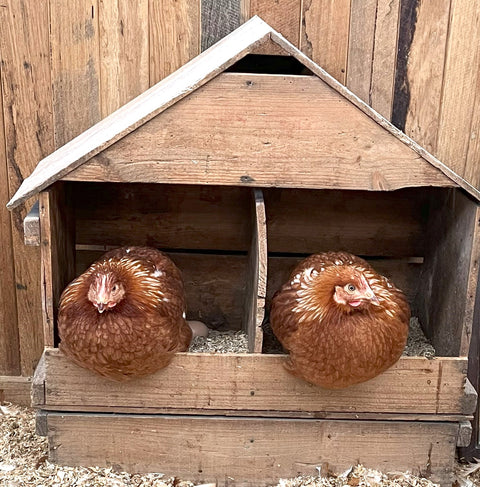You’ve probably noticed that there’s a queue at the nesting boxes every morning lately thanks to one broody hen creating a bottleneck!
As the mercury rises, so does a hen’s hormones which means that some purebred girls may be tipped into going broody.
This natural mothering instinct can last as long as it takes to incubate a fertilised egg (about 21 days). That's just fine and dandy if that’s what you want but a potential problem if the eggs are bound for your kitchen instead.
How will you know if she’s gone broody?
To begin with, you may hear telltale calls of chickens desperate to lay an egg - a broody hen will commandeer the nest box both day and night, thus blocking access for others.
She will sit low, spread herself wide and be as big and scary as possible with puffed-up feathers, a high pitch screech and the odd peck directed at those who dare venture near.
She may have plucked her breast bare in an effort to keep her eggs at the right temperature against her toasty, warm skin.
Meanwhile, you may also see giant sphere shaped droppings about the coop that better resemble an egg (if not for their dark colour). These are the bombs she’s withheld whilst sitting and releases once daily.
Why is broodiness a problem?
Of course, broodiness in itself isn’t a problem but it can compromise health and lead to other issues in the coop.
For the hen herself, she can lose condition without regular access to food and water, which may leave her susceptible to illness. She also becomes a sitting target for mites and lice because she’s not dust bathing and staying put in one place.
Most importantly though, she risks overheating in summer.
On the other hand, her broodiness also impacts egg production. Not only are you missing out on her eggs (hens don’t lay while broody), she may also block access to nest boxes for other chickens who are forced to find an alternative (introducing other problems).
Here’s how to tackle broodiness
1. Do nothing
It’s perfectly fine to let her do her thing if it doesn’t upset the coop order. However, ensure she has easy access to food and water plus closely monitor her condition. Mites, lice and hot days are her biggest threats so make sure you provide a good shaking of Bugs Away in her nest and bedding materials.
2. Remove her from the nest box
Simply lift her out of the nest box (remove any eggs) and place her with the flock. You may consider using healthy treats to encourage foraging so that she’s not tempted to return too quickly. Repeat throughout the day if necessary.
3. Close the hatch
You’ll also benefit from blocking off the nesting boxes once daily eggs are laid. Be aware that your broody girl may become frustrated, vocal and end up finding another spot to sit.
4. Cool her down
Interestingly, the hormones associated with broodiness lead to an increase in a hen’s core temperature. So, if you can reduce her temperature, you reduce broodiness. On a warm day, try submerging her undercarriage in cool water for a few minutes. Or, you can place an ice pack in her preferred nesting box for a few days in a row.
5. Confinement
Lastly, if you’ve done everything and she still wants to sit then try separation. The goal is to make her broody behaviour uncomfortable. As such, plenty of ventilation and natural daylight are important and meeting her food and water needs remains vital.
A raised wire cage works best – don’t include bedding and place it inside the coop (so it’s social and safe). Each morning release her and observe. Repeat until she no longer makes a beeline for the boxes!
Further tips
- Routinely remove eggs from nesting boxes immediately after laying
- At this time of year, block off nest boxes once eggs are laid for the day
- If you’ve got a broody girl, change and clean the nest box frequently with fresh hemp so as not to encourage mites and lice
- Once its dark, place your broody girl on the roost







Comments (0)
There are no comments for this article. Be the first one to leave a message!